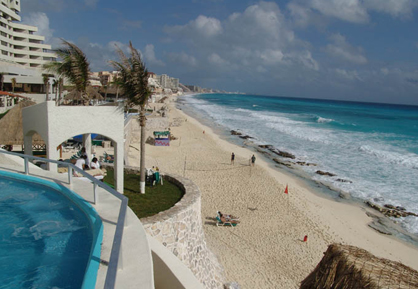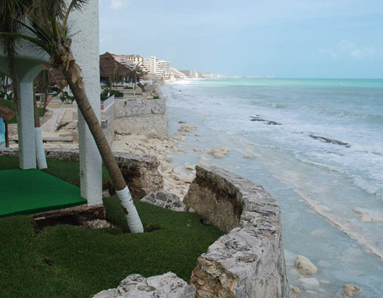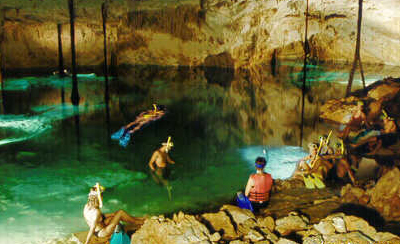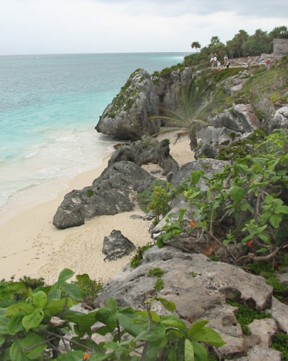Geotimes

Untitled Document

Travels in Geology
March 2006
 Cancún
and beyond
Cancún
and beyond
For many students, it's spring break, and time to head someplace warm. One
of the quintessential spring break destinations is Cancún, on Mexico's
Yucatán Peninsula, but you don't have to be a party-hopping college student
to enjoy this site. Look beyond the typical vacation of lounging on the resort
beaches of Cancún and sipping margaritas (you can do that too), and be
sure to venture south and explore some Maya ruins as well as the region's remarkable
system of caves and sinkholes.
 Now
is a good time to head to Mexico's Yucatán Peninsula, not only for the
spring break revelry, but also because mid-December through April boasts the
best weather. Airfare tends to be more expensive during this time, but for those
willing to do a little research, good deals abound, especially as the region
tries to entice tourists back following the devastating strike of Hurricane
Wilma last year.
Now
is a good time to head to Mexico's Yucatán Peninsula, not only for the
spring break revelry, but also because mid-December through April boasts the
best weather. Airfare tends to be more expensive during this time, but for those
willing to do a little research, good deals abound, especially as the region
tries to entice tourists back following the devastating strike of Hurricane
Wilma last year.
Hurricane Wilma stalled over Cancún
last October, leaving in shambles hotels and beaches in a city that depends
on tourism (left). Now, however, the majority of the hotels, restaurants and
attractions were back in business (right), although construction continues.
Both photos are courtesy of John Spina (www.hurricanewilmacancun.com).
Wilma struck Cancún on Oct. 21 and stalled there for 40 hours, flooding
much of the city and stranding residents and tourists in homes and hotels with
no electricity or running water. But Cancún tourism
officials say that more than half of the hotel rooms are back open now, and
most restaurants and clubs are open as well (although spring break revelers
won't find the usual MTV beach parties, according to the Boston
Globe). The city's famed 25 kilometers of white sand beaches are all
open, even as multimillion dollar beach restoration projects continue.
Regions farther south of Cancún, sheltered by the offshore island of
Cozumel, sustained less damage from Hurricane Wilma, and
thus have seen a rise this year in tourism from people who might have otherwise
gone to Cancún itself. Most hotels, restaurants and golf courses in the
southern areas are open, and tourism officials say that now is a great time
for diving, as underwater disturbances from the storm exposed some never-before-seen
cave systems.
Driving an hour and a half south from Cancún, you'll reach an area famed
for its underwater caves: the Riviera Maya. A multitude of snorkeling and diving
tours of the caves are available for visitors of any level of experience. Try
Chankanaab National Park on Cozumel, which just reopened with new underwater
trails, or Hidden Worlds Cenotes Park in the Riviera Maya,
which happens to be featured in the popular 2001 IMAX movie Journey Into
Amazing Caves.
 Hundreds
of kilometers of caves formed on the Yucatán Peninsula because of its
unique geology. The region is composed of flat limestone bedrock, which is highly
susceptible to erosion from acidic rain. Prior to about 11,000 years ago, the
caves appeared like any other modern dry cave, complete with stalagmites and
stalactites. Following the end of the last ice age, however, the water table
rose, submerging caves and filling sinkholes (called cenotes in the Yucatán).
Hundreds
of kilometers of caves formed on the Yucatán Peninsula because of its
unique geology. The region is composed of flat limestone bedrock, which is highly
susceptible to erosion from acidic rain. Prior to about 11,000 years ago, the
caves appeared like any other modern dry cave, complete with stalagmites and
stalactites. Following the end of the last ice age, however, the water table
rose, submerging caves and filling sinkholes (called cenotes in the Yucatán).
Snorkeling and diving in submerged
sinkholes, called cenotes, are favorite activities in the Yucatán. Visitors
can take guided tours through entire underground cavernous systems, or explore
some from the surface on their own. Photo is courtesy of Hidden
Worlds Cenotes Park.
If diving or snorkeling does not interest you, plenty of other options exist
for adventure in the Riviera Maya. Tulum Ruins, a small Maya ruin site, is the
closest to Hidden Worlds Cenotes. The site also boasts a swimming beach, restaurants
and shopping. Do not visit the Yucatán, however, without visiting the
large and popular Chichén Itzá ruin. At this site, you can tour
sacred cenotes and view a well-maintained pyramid and other archaeological artifacts.
You can join any number of organized groups for a tour of Chichén Itzá,
which is only three hours west of Cancún on Highway 180. TravelYucatan.com
is a great Web site to visit to help you plan your trip.
If time permits, you can continue west on Highway 180 to Merida, the capital
city of Yucatán state. Just offshore of the west side of the peninsula
is the center of the famous 180-kilometer-wide Chicxulub
impact crater, which many scientists say is evidence of an impact that killed
off the dinosaurs 65 million years ago. Whether or not the 10-kilometer-wide
meteor killed the dinosaurs, the crater has left a lasting impression. NASA
images suggest that the impact altered rocks below Earth's surface, so that
when limestone deposits later formed and then eroded, a shallow trough appeared
to the west and a ring of sinkholes formed to the east of the crater's rim.
Such cenotes are the only obvious evidence for visitors of the otherwise buried
crater.
All throughout the Yucatán, Maya
ruins abound, such as Tulum Ruins in the Riviera Maya region about 100 kilometers
south of Cancún. Photo is courtesy of Travelyucatan.com.
Merida also happens to be a great place to experience colonial Yucatán
culture that you most likely will not find in Cancún. Get a taste of
traditional food, music, dance and fashion, all within walking distance of most
hotels. Also, check out any of the tours that leave from Merida, such as an
excursion into the jungle or to more Maya ruins.
Whether you head to Cancún or farther into the Yucatán, it's
easy to find adventure — and better weather than most people on the U.S.
mainland are seeing in March. The weather in Cancún right now: sunny
and 84 degrees.
Kathryn Hansen
Links:
Tourist
information from the Cancún Convention and Visitors Bureau
Travel
infomation from Cancun.com
Isla
Cozumel official government site
CometoCozumel.com
Travelyucatan.com
Yucatán
information from Frommers
Hidden
Worlds Cenotes Park
Hurricane
Wilma's effects on Cancún
News
article on Spring Break from Boston Globe
"Unraveling the Chicxulub
Case," Geotimes, January 2004
Travels in Geology
Back to top
Untitled Document

 Now
is a good time to head to Mexico's Yucatán Peninsula, not only for the
spring break revelry, but also because mid-December through April boasts the
best weather. Airfare tends to be more expensive during this time, but for those
willing to do a little research, good deals abound, especially as the region
tries to entice tourists back following the devastating strike of Hurricane
Wilma last year.
Now
is a good time to head to Mexico's Yucatán Peninsula, not only for the
spring break revelry, but also because mid-December through April boasts the
best weather. Airfare tends to be more expensive during this time, but for those
willing to do a little research, good deals abound, especially as the region
tries to entice tourists back following the devastating strike of Hurricane
Wilma last year. 
 Cancún
and beyond
Cancún
and beyond
 Hundreds
of kilometers of caves formed on the Yucatán Peninsula because of its
unique geology. The region is composed of flat limestone bedrock, which is highly
susceptible to erosion from acidic rain. Prior to about 11,000 years ago, the
caves appeared like any other modern dry cave, complete with stalagmites and
stalactites. Following the end of the last ice age, however, the water table
rose, submerging caves and filling sinkholes (called cenotes in the Yucatán).
Hundreds
of kilometers of caves formed on the Yucatán Peninsula because of its
unique geology. The region is composed of flat limestone bedrock, which is highly
susceptible to erosion from acidic rain. Prior to about 11,000 years ago, the
caves appeared like any other modern dry cave, complete with stalagmites and
stalactites. Following the end of the last ice age, however, the water table
rose, submerging caves and filling sinkholes (called cenotes in the Yucatán).

